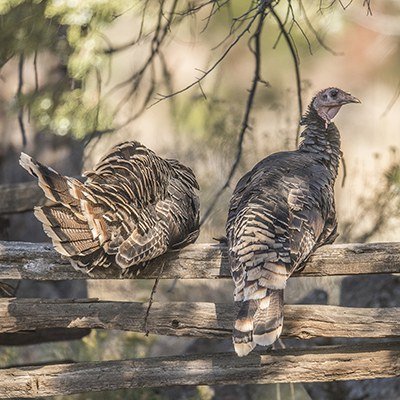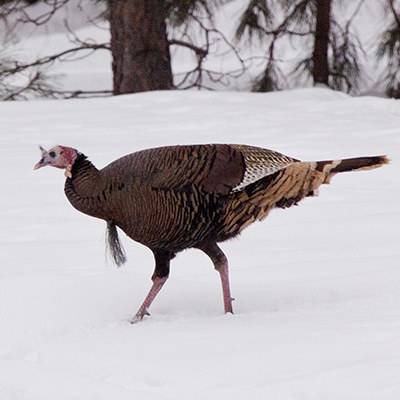As family and friends gather together for the holidays, spend some time learning your wild turkey facts. Then, impress everyone at the dinner table with your knowledge!
Oregon Transplants: Did you know that turkeys are not native to Oregon?!? Wild turkeys have an original range in the United Sates from Arizona north and east across the Midwest and Texas to New England and Florida. In 1899, private individuals began to release farm-raised turkeys in southern Oregon without success. The Oregon Department of Fish and Wildlife first successfully introduced wild turkeys in 1961 by trapping and relocating 58 Merriam’s wild turkeys to the state. Since then, more than 10,000 turkeys have been relocated to Oregon. It is estimated that there are now 25,000-27,000 Rio Grande wild turkeys and 2,000-3,000 Merriam’s/Rio Grande hybrid turkeys in the state.
Gobble, Gobble, Gobble! Turkeys have 28 distinct vocalizations, but their most well-known is the male’s gobble. It is heard primarily in the early morning while still roosting and in the evening. The gobble vocalization is made in response to calls from females and other male gobbles, as well as to loud noises like sirens, thunder, and dog barks.
Birds of a Feather Flock Together: Wild turkeys live in flocks of the same sex except during the breeding season. Their flocks can range from a handful to several hundred. Wild turkey flocks may move over 20 miles to winter range, which is usually at a lower elevation than their spring and summer range. Wild turkeys roost in trees.
Beards, Wattles, and Snoods, Oh My! Both male and female wild turkeys have beards. The beard is not considered hair, but a type of modified feather. Unlike feathers, however, turkey beards grow continuously. Wattles are fleshy growths on the head or neck in several groups of birds and mammals. The wattle along the wild turkey’s neck is thought to be for mating displays. The male turkey’s wattle can become engorged with blood and turn various shades of red, white, and blue. The snood (a type of wattle) is a fleshy protuberance on the forehead of turkeys. It is thought to be used in the mating process, with females preferring males with longer snoods. The snood is also used in male interactions, with the shorter snood male deferring to the longer snood male.
Learn more about other animals found on Land Trust Preserves:


